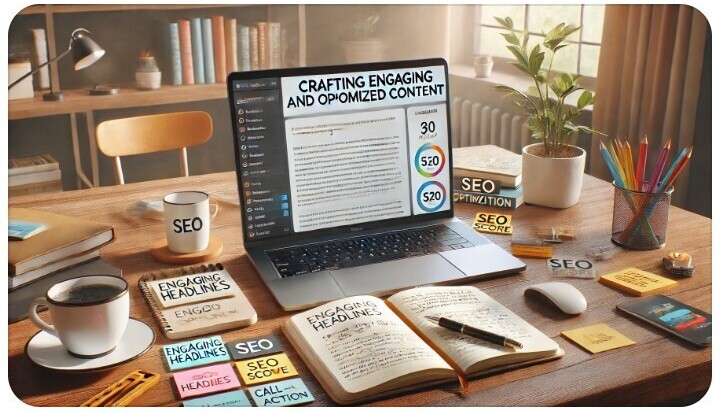
On-page SEO is the cat’s pajamas for affiliate marketers! It involves optimizing individual pages to rank higher and earn more relevant traffic. But why should an affiliate marketer care? Well, without it, your carefully curated content might just sit in a digital desert, unnoticed and unappreciated.
Let’s kick things off with the core elements of on-page SEO: titles, headlines, meta descriptions, and keywords. These might sound like technical jargon, but they’re basically the bread and butter of your web presence.
Crafting captivating titles and snappy meta descriptions can actually double up as your digital sales pitch. They should intrigue and inform simultaneously, easily enough, right? Also, keywords.
They’re the bridge to your audience. You get them right, and you’re speaking their language. Sticking them here, there, and everywhere is a bad idea. Instead, sprinkle them naturally throughout your content web pages, especially in headings and opening paragraphs.
Now, what about user intent and experience? These aren’t just buzzwords! They are what truly matters to search engines. When someone’s searching for beauty tips, they want content that’s helpful, not a sales trap.
Deliver value, and Google will reward you with a thumbs up and better rankings! Putting yourself in the shoes of users helps create content they’ll genuinely appreciate, leading to higher engagement and conversion rates.
Crafting, Engaging, and Optimized Content
Creating content that not only attracts eyeballs but also holds them involves a bit of art and a lot of strategy. The trick? Knowing what your readers want and giving it to them in a way that keeps them coming back for more. Think of it as cooking a dish where each ingredient plays a crucial role in the final taste.
High-quality content matters more than ever. It’s not just about stuffing keywords anymore. It’s about writing content that addresses your audience’s needs and questions. So throw those keyword-stuffing tactics out the window and instead focus on weaving keywords naturally into the narrative.
Think of keywords as your content’s spice. They need to be there, but you don’t want them overpowering the dish. Carefully placed and perfectly measured, they’ll enhance the flavor of your SEO efforts.
Content length, structure, and readability are your bread and butter here. A wall of text is a surefire way to lose anyone who stumbles upon your page.
Organize your thoughts into bite-sized paragraphs and sections with headers that make it easy for readers to find exactly what they need. Add a dash of personality to keep things lively. Remember, people are drawn to authenticity and simplicity, so keep things straightforward and engaging.

Leveraging Visuals for SEO and User Engagement
Visuals aren’t just decorations; they’re game-changers in the realm of affiliate marketing. They draw people in, provide clarity, and can even explain what words sometimes can’t.
Images and videos are crucial. They have the power to break monotony and keep your audience glued to your page. A relevant image can highlight a point quicker than a thousand words, while a video can turn complex ideas into digestible, entertaining content.
But visuals aren’t just there to look pretty. To make them work for you and not against you, optimizing images with proper alt text and descriptions is the way to go.
Alt text is your opportunity to tell search engines what the visual is about. Keep it descriptive yet succinct, incorporating your main keywords where natural. It also enhances your site’s accessibility, making it easier for screen reader users to know what’s up.
Infographics and interactive elements bring engagement to the next level. People love visuals that offer quick and comprehensive insights. Infographics make data relatable and interesting, while interactive tools or widgets can engage users actively, encouraging them to spend more time on your site. This boosts the user experience and provides insights into user behavior.
So, don’t just throw visuals onto your page. Make them an essential part of your SEO strategy. They should enhance what you’re saying, clarify complex information, and invite further exploration. Next time you craft an article, think about how visuals can add value and keep your audience coming back for more.

Enhancing Website Performance and User Experience
When it comes to keeping visitors happy and engaged, speed and responsiveness are your best friends. A slow-loading site frustrates users, potentially sending them running into the arms of your competitors. You want your site to feel like a finely tuned sports car that is fast, smooth, and ready to go anywhere.
Page speed isn’t just a nice-to-have; it’s crucial. Compress images, leverage browser caching, and minimize code to speed things up. Users expect lightning-fast results, and search engines do, too.
Then, there’s mobile responsiveness. With so many accessing sites through their phones, having a website that looks and operates seamlessly on mobile is key. Ensure your design adapts beautifully across devices, making navigation intuitive and content easy to consume no matter the screen size.
Good navigation is like a well-laid map guiding users through your site. A logical site structure helps visitors find what they’re looking for without busting out a treasure map. Implement clear internal linking to guide users seamlessly between sections.
Breadcrumbs are more than just fairy tale trails. They provide context and help users know exactly where they are on your site at all times. Meanwhile, boosting site accessibility can open your content to audiences who use unique technologies, making your site everyone-friendly.
Focus on these elements to ensure visitors not only find your site but stick around long enough to appreciate the content and take action.
Building E-E-A-T Oriented Content
E-E-A-T stands for Experience, Expertise, Authoritativeness, and Trust, a framework that’s as essential as air for affiliate marketers looking to boost their SEO game. It’s all about showing you know your stuff and that you’re the real deal!
Kicking things off with expertise is all about demonstrating your knowledge in your niche. Share insights, show off your credentials, and deliver content that addresses real questions and needs. Whether it’s a compelling case study or a deep-dive tutorial, let your prowess shine through.
Authoritativeness isn’t just about shouting from the rooftops. It’s about citation and evidence. Referencing authoritative sources and backing your claims with solid research can solidify your content’s authority. Feel like a genius yet?
Trust signals can’t be skipped. Users need to feel confident in what they’re reading. Consider having a detailed author bio with credentials and links to other credible pieces you’ve published. Ensure your site has an SSL certificate and that all user data policies are transparent and respected.
Think of E-E-A-T as your compass. It guides your content creation and lets search engines know you’re someone users can rely on. Seeing your site earn trust and higher positions in search results is a win you’ll want to experience firsthand.

Analyzing and Adapting Your SEO Strategy
Keeping a pulse on your SEO efforts is crucial. It’s not a one-and-done job; it’s an ongoing commitment to growth and adaptation. The ability to fine-tune and adjust your strategies based on data-driven insights is what keeps your site at the top of its game.
Tools like Google Analytics and Search Console are invaluable for assessing your on-page SEO. They provide a wealth of information about who’s visiting your site, how they find you, and what they’re doing once they arrive. Dig into these metrics to uncover the truth of what’s working and what’s not.
Key performance indicators (KPIs) like bounce rate, session duration, and conversion rates will give you a clear picture of your site’s performance. If visitors are bouncing off too soon, it might be time to reevaluate your content strategy or page design.
SEO trends and search engine algorithms always evolve, and staying current is your secret weapon. Subscribe to industry-leading blogs, attend webinars, and participate in forums to keep your knowledge fresh. This proactive approach ensures you’re not caught off guard by changes that could impact your rankings.
Don’t be afraid to experiment with new ideas and test different strategies. SEO is as much about creativity and innovation as it is about understanding data. Keep adapting, keep learning, and most importantly, keep optimizing to maintain your edge in the affiliate marketing world.
If you want to read about creating quality content for a website, you can learn how to write quality content here.
To learn more about Howard, you can check out this article.
My involvement in operating an online business started in 2014, and I did not do it alone! Online success takes hard work, perseverance, and help to learn all these things.
The industry is constantly changing, especially with the growth of Artificial Intelligence (AI) in the online world.
If you want to be taught how to create great website content and have an online business that could make you income 24/7, 365, then you may want to check out how I did it. I used this source to learn, engage with others for assistance, and create online income using multiple affiliate marketing sources.
You can also reach out to me by leaving a comment below. I will get back to you!
Can You Afford to Not Make Money Online?

